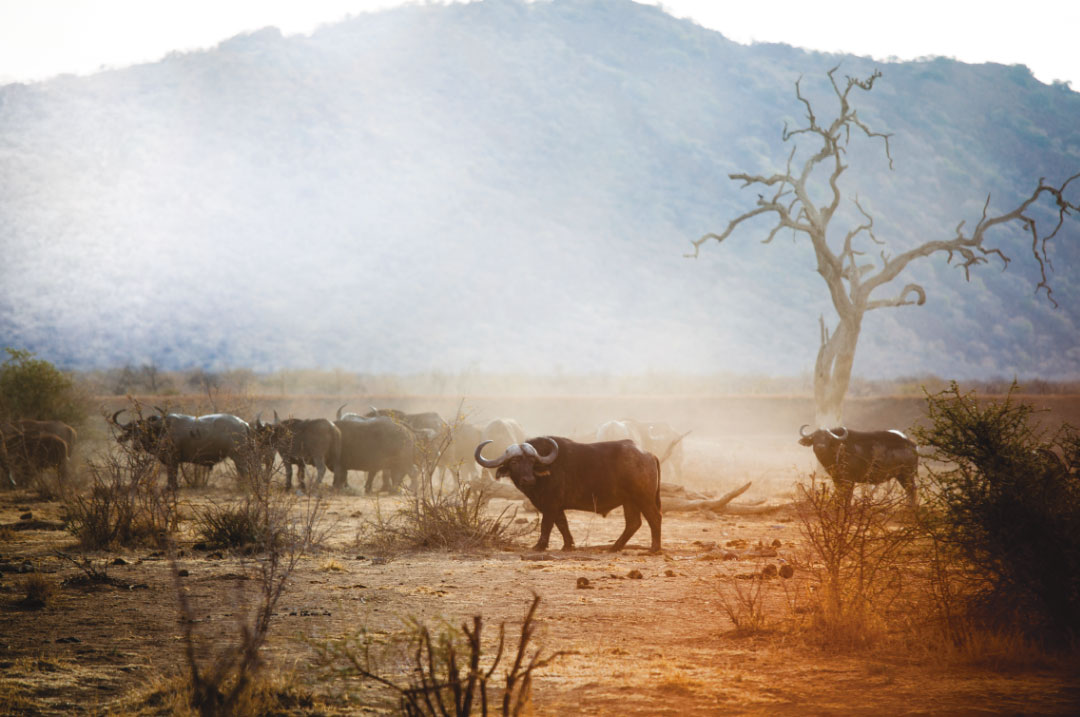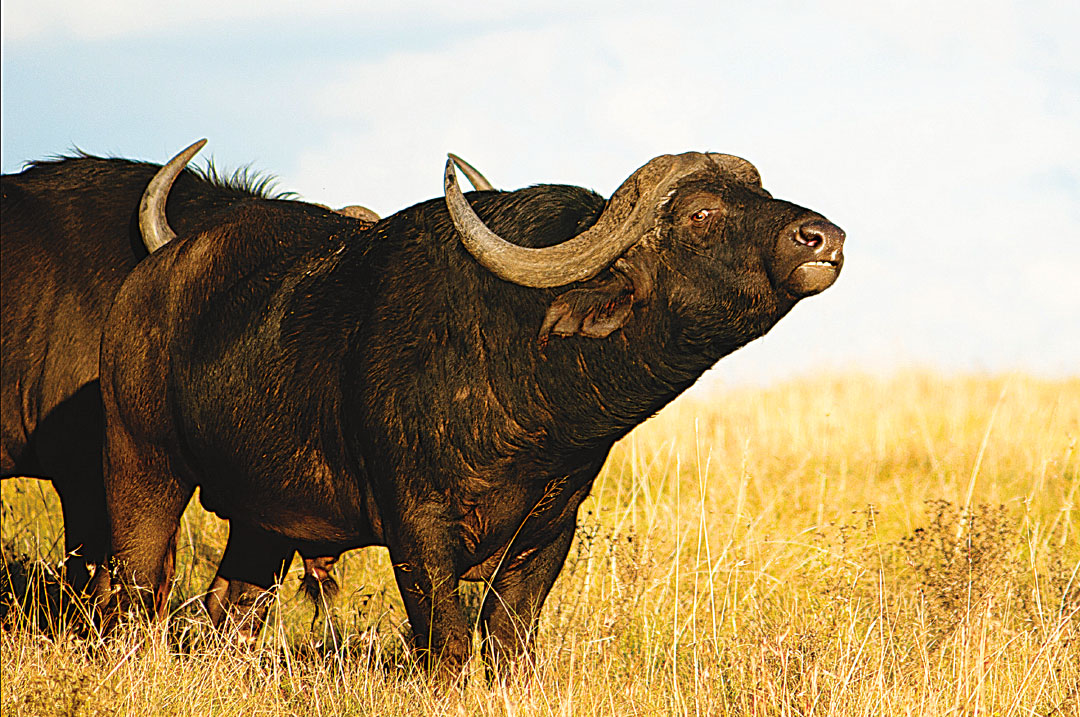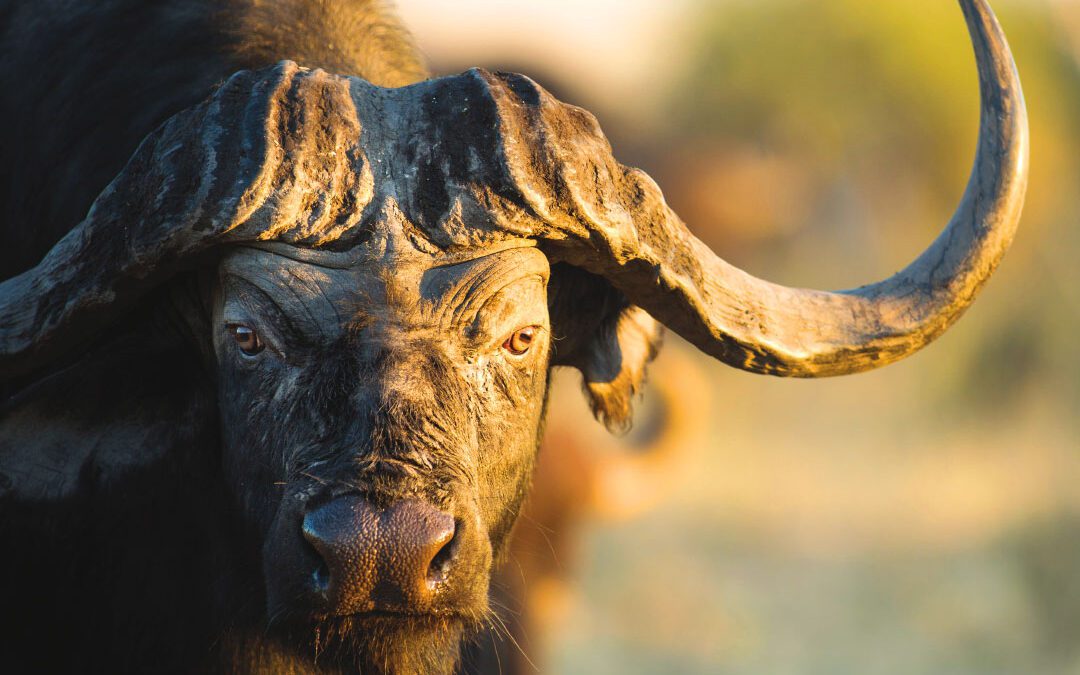What or where to hunt was not in doubt: I wanted to hunt Cape buffalo in Tanzania. It may have been the buffalo charge in The Short Happy Life of Francis Macomber, or perhaps the sweaty terror that buffalo evoked in Ruark’s Horn of the Hunter, I really don’t know. Probably both, along with a healthy dose of Peter Capstick’s tall tales and that wonderful, menacing stare captured in so many photographs of old Cape buffalo bulls. Whatever the source, it was buffalo more than lion, leopard, or anything else that fired my safari daydreams as I planned that first trip.
The reality turned out to be better than the books or the daydreams. Across a dozen Tanzanian safaris, each bull I hunted showed a new side of the buffalo’s character, each hunt unfolding like a chapter in a book I would have dismissed as fiction if I hadn’t lived it.
My first bull came the hard way: day after day following tracks through thornbush and granite hills, culminating in a long afternoon spent belly-crawling across a burnt floodplain praying the wind would hold. The sheer size of that bull, magnified of course by the perspective one gains from peering up from weed level, was captivating. I remember how even in death he lost none of the tremendous gravity his bulk conveyed.
My second bull, by contrast, was pure slapstick. Eight days into a lion hunt we had taken only a single zebra for bait, the rest of the animal world having seemingly decamped en masse for who knows where. Suddenly, our picnic lunch was enlivened by an old bull who materialized absent-mindedly from the surrounding bush, then elected to make his exit by galloping directly past, and nearly over, our table.

In the scramble that ensued, I managed to retrieve my rifle, miss the bull as he zigged, then anchor him just before he zagged into some very nasty bush. The entire comedy was played out as if staged expressly for the benefit of our trackers, who were enjoying their own picnic on a hill behind us and must have been in stitches. Each of them made sure he got pictures of himself sitting astride that buffalo.
The third bull was an introduction to the almost mythical toughness of Cape buffalo. Shot twice through the shoulder and heart with 400-grain solids from my .416 Rigby, the bull ran a half-mile to the nearest deep thicket, turned, waited, and when we got close enough to suit him, charged. That bull soaked up more than 40,000 foot-pounds of kinetic energy at close range before he finally quit.
Bull number four was a thug, the only truly vicious wild animal I’ve ever met. A very old bull, he had retired to a remote valley in the Matale hills of northern Tanzania where he vented his temper from time to time by chasing, and on at least one occasion killing, the Maasai herdsmen. We had tracked him into some dense bush when he turned the tables and charged out of the shadows at 20 feet. We dropped him in time, but barely.
Just two days later we enjoyed another near-mythical hunt that began with a double rainbow at sunset over my tent—a portent to be sure, but of what? What it portended, we would discover the next morning, was a ten-mile venture into unhunted, mist-shrouded hills, culminating in a mad rush down one mountain and up another to head off the bull of a lifetime before he disappeared. We caught him just as he reentered a tangled mess of thornbush and killed him at 16 yards. He was the largest bull to come out of Tanzania that year and remains the finest trophy I’ve ever taken.
In the years since those first safaris I’ve hunted buffalo as often as I could, and have especially enjoyed helping with the tracking and skinning while friends did the shooting. Most recently I returned from an exhilarating week exploring a new area called Makame in southern Masailand with veteran PH George Angelides and his son Nick. Makame has been open to hunting for many years but was designated a Wildlife Management Area in an effort to help restore the local game population. George picked up the concession in 2014 and began the long process of rebuilding camps and roads and evaluating the area’s hunting potential.
Early indications were promising for East African species such as lesser kudu, Grant’s gazelle, and gerenuk; excellent for birds, lions, and leopards; and somewhat surprisingly in light of past hunting pressure, excellent for buffalo. It seems that most of the hunting over the last decade was confined to areas where access was readily available, leaving huge tracts of thick, inaccessible thornbush as a kind of buffalo safe haven. The only problem was getting to them.
I first heard about Makame from former PH Joe Coogan, who has been working with George to organize wingshooting safaris in the area. When George mentioned to Joe the possibility of an exploratory buffalo hunt in tough country, Joe knew I’d never be able to resist the adventure. He was right. After a few phone calls the safari was set for mid-July. Our plan was to hunt early in the season before the waterholes had dried up, enabling us to find tracks near water in the morning and catch up with an old bull before dark.
And that’s what we did for seven straight days of some of the most challenging and exciting hunting I’ve enjoyed in years. Each day we were able to find good tracks—old bulls either alone or in groups of two or three, the edges of the tracks still sharp and fresh from the night before as the buffalo exited the mud surrounding the waterholes.

Each day we followed those tracks into the thickest bush I’ve ever hunted: interwoven thorns of every description, visibility usually less than ten yards, often less than ten feet, and the ground baked hard as only the African sun can bake it. It was hot and dry, and sometimes frustrating beyond belief as we tried to distinguish tracks that showed only as faint scuffs and scratches in the dappled light.
Hour after hour, mile after mile we followed deep into seemingly endless thickets and always the buffalo beat us. The midday wind would swirl at the last minute and hours of patient stalking would disappear in a crackle of breaking thorns as the bull escaped unseen at 20 yards, sometimes less, and the long tracking would begin again.
A couple of times we caught a glimpse of a vague black form crashing off in a muffled thump of hoofbeats, and on one occasion I almost managed to put the sights of my .500 double on a bull as he stood up from his bed. Had that bull waited even two seconds to check us out, we’d have had him, but he didn’t.
By the fourth or fifth day we found ourselves wishing one of those bulls would get irritated enough to turn and come for us, a wish that may not have been particularly sensible, but at some point you just want to call the question. Masailand buffalo are notorious for having short tempers due to constant interaction with the Maasai, but these bulls seemed to prefer discreet escape to battle when given a choice.
This aspect of the Cape buffalo’s character sometimes gets overlooked because of all the emphasis on their aggressive qualities.
When I began hunting buffalo, I thought that whatever courage was of interest would be my own. Now I believe I was wrong about that. Obviously, it takes a certain level of will to walk into thick bush after a bull, but fear of shame or even outright stupidity can make you do it, and neither should be confused with courage.
What I’ve learned about courage in buffalo thickets I’ve learned from the bulls themselves. The Cape buffalo is not a bully, but once engaged he will do everything in his power to beat you until one of you wins. There’s something about the single-minded violence of those moments that expresses something fundamental, and there’s something about the potential for that violence—regardless of whether a particular buffalo chooses to be aggressive or just cleverly evasive—that makes every buffalo hunt engaging.
That’s why I am convinced the Cape buffalo is the greatest game animal on earth. From the fine, sharp smell when you wind one unseen in close cover, to that splendid baleful, unforgiving stare, to the gut-grabbing violence of a charge, there is something supremely immediate and unequivocal about an old bull. That truth, I believe, is what gave the Cape buffalo stories of my childhood such power and what makes me certain that, for as long as there are old bulls in wild places, I will return to hunt them. I keep going back to those thickets and I keep learning. I doubt I’ll exhaust the subject in a lifetime.
OUTFITTERS & AREAS
Considering a Tanzanian buffalo safari? The country boasts numerous outfitters and professional hunters operating in good buffalo areas. The following list, which is far from exhaustive, includes the companies, professional hunters, and areas I know best:
Tanzania Game Tracker Safaris offers outstanding buffalo hunting in its Maswa and Moyowosi concessions, where Professional Hunter Paul Olivier delights in ferreting out big bulls. I shot my largest buffalo in their Lake Natron concession, but while the area does contain some buffalo, opportunities there are generally more limited. Bookings are arranged through the company’s U.S. affiliate, Legendary Adventures (www.legendaryadventures.com); email: paul.olivier@tgts.com.
Masai Plateau (TZ) Ltd., operated by George Angelides and his son, Nick, has the Makame concession mentioned in the article. No one knows Masailand or Masailand buffalo better than George, whose family has farmed and hunted the area since the 1890s. Makame is graduate-level buffalo hunting, but if it’s adventure you’re after, it’s all that and more. Email: masaiplateausafaristz@gmail.com.
Danny McCallum Safaris has four contiguous hunting areas comprising roughly a million acres, known collectively as Lukwati, that hold excellent buffalo. We shot four good bulls in Lukwati in 2013 and saw others that were even more impressive. Email: safaris@dmstz.com.
Ian Batchelor, a PH friend with whom I’ve hunted a lot of big buffalo, hunts Tanzania with Robin Hurt Safaris. Ian says their Luganzo, Rungwa, and Mlele areas are good for buffalo, as is their Losimangor area in Masailand. Email: isbatchelor@aol.com.
RIFLES & AMMO FOR BUFFALO
There are a lot of good rifles out there, and there’s certainly no single “best” rifle for buffalo. The legal minimum caliber for buffalo in Tanzania is .375. The .375 H&H remains a perennial favorite and is probably the cartridge most often recommended by professionals for first-timers.
I took my first two buffalo with a customized Winchester Model 70 in .375 H&H using Barnes solids, and it worked beautifully. My favorite bolt gun for buffalo is a Dakota Model 76 in .416 Rigby, usually with Barnes TSX bullets. I especially like the Swarovski 1.25 x 4 scope with circle/dot reticle on that rifle, a combination I’ve found to be very fast on charging bulls.
On my last two safaris I carried a lovely Holland & Holland round-action double in .500 Nitro Express, using mostly Hornady DGS bullets. Nothing feels better in your hands than a nice double, especially in very tight cover, although as my eyes grow older, I have to admit that a scope would make it easier to distinguish a black buffalo from a black shadow.

